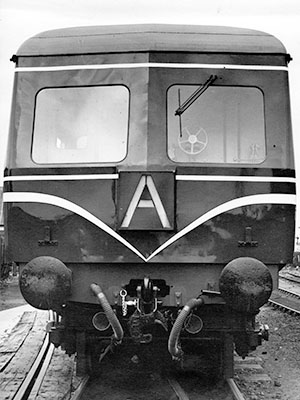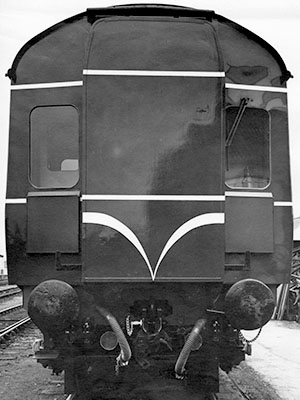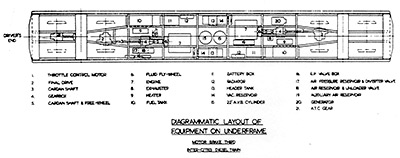Swindon Inter-City 79xxx series 3/6-car DMUs
Description
These were the first DMUs ordered to be built on the longer 64'6" underframe, and the first from BR's Swindon Works. In common with the 'Standard' (now called Mark I) coaches being built at the time they were of steel construction with Pullman gangways and buckeye couplings.


There were two front-end designs: either a full-width "leading" cab or a "intermediate" half-cab with central gangway connection (a gangway cover is fitted in the image). The "intermediate" driving car allowed through access to all vehicles when two 3-car sets were coupled as a six-car set, or when the intermediate car was used as an inner power car. The cab fronts were very plain - no destination blinds, route indicators or marker lights. They had a very basic illuminated box which held a stencil indicating the train classification (A, B or C; later changed to 1, 2 or 3). The leading cars had one, the intermediate power cars had two, one on either side of the gangway.
The difference between the two DMBS types (leading and intermediate) was only the front few inches. The rest of the layout, from the van through the passenger accomodation and toilets at the rear - was identical.
The article 'Building a DMU' looks at the construction of the vehicles in detail.
Mechanical
The diagram shows the layout of the equipment on the underframe. Each power car was fitted with two AEC 150 h.p. underfloor engines with mechanical transmission giving a maximum speed of 70 m.p.h.
The brake van was immediately behind the cabs in the 'leading' power cars, and there were two types of 'intermediate' power cars, with and without vans (DMBS and DMS). The vans were also immediately behind the cab on the DMBS, the DMS had a toilet and vestibule directly behind the cab. This meant that none of the vehicles could offer the passengers a view of the line ahead through the cab parition, one of the most popular features on other types of DMUs. The main reason for this was that as they were considered 'Inter-City' stock operating on a main line, and rules in place at the time specified there must be a brake van at the extreme ends of the passenger accomodation on the train. It led to a lot of criticism from the public, as did the plain "utility" appearance of the 'leading' cab front.

"An exciting moment in the process of building inter-city diesel train sets at Swindon Works as a diesel motor is trolleyed into position ready for fitting." This was a cover image on the March 1956 British Railways staff magazine.
They had a unique multiple-working control system (coded White Circle). Unlike other systems, there was no through air pipe connecting the vehicles, each power car relied solely on its own control air supply. It made no difference to the operation of any of the pneumatic systems, however a power car with air problems could not be at the leading end of a formation as the horn could not be operated. Electrically the control system was an advancement of the yellow diamond system used on other 79xxx DMU vehicles with the same cab controls, but had the addition of relays for better through-train control. When the 5xxxx series Swindon Inter-City vehicle were delivered, a modification was required to make them compatible as the later vehicles were based on the blue square system.

Interior
Power car passenger seating was second class in open saloons - the image shows inside an intermediate brake third. There was no centre passenger doors on these vehicles, just one long saloon. Unusual for DMUs, the dividing partition did not have windows, and curtains are fitted in third class. Trailer cars contained first class seating in seven compartments except the buffet cars which were formed of three compartments at one end, an open buffet area with three tables for sitting and a standing area with mini table, and the serving / kitchen area.

The corridor walls and compartments were veneered, and compartments would have a trafolyte plaque giving the name of the veneer used.
Summary
Description
Adverts
Diagrams
Drivers Instructions
Numbering
Liveries
Operations
- Western Region
Non-Passenger / Foreign Use
Images
Miscellaneous
Details about preserved Sc79443 can be found here.



